Hi Guys and Gals.... it's matte magic time once again, with a healthy round up of films and genres, from a wide spectrum indeed. I've got 'B' grade monsters, big budget Technicolor fantasy, gritty British WWII action, a thirties comic classic, a VistaVision epic, a wonderful Disney true story, and to top it off, a biopic of the late Tina Turner! Plus, a long forgotten and previously unidentified matte shot by Albert Whitlock when he was in England in the 1940's is also in today's line up! And as if that weren't enough, I've got a cavalcade of rarely seen Matte World paintings that are currently being auctioned off. You can't accuse Pete of shirking his vfx responsibilities! There is nothing worse than an online search that leads you to some disappointing venue where you get not much more than a paragraph of text and 3 pictures (if you're lucky). Not so here. It's an 'all or nothing' kind of a gig for Pete.
There's something here for everyone (well almost everyone)... though, please make the effort to view on a proper sized monitor/screen/laptop. If I find anyone viewing these blogs on a damned cellular phone toy thing, I will find you, and, mark my words, 'go full Liam Neeson on your sorry arses'! ;)
***Oh, and just before we begin the thrilling ride, an important disclaimer: None of the following (nor preceding blog posts for that matter) have been created through 'AI' - Artificial Intelligence (some might dispute the term "intelligence" in any respect with my blogs, though I digress...), nor through that godammed CHAT-GPT, whatever the hell that is! It's all the real deal... a labour of love, from Pete. All 'old fashioned, traditional, hand crafted blogging'... just like those old matte shots I love so much. 'AI'.... well fuck 'em I say!
Enjoy
NZ Pete
-------------------------------------------------------------------------------------------------------------------------
YOU TUBE SERIES ON THE WORK OF AL WHITLOCK AND SYD DUTTON
Firstly, I must do my duty and make mention (and firm recommendation) of my pal Thomas Higginson's ongoing YouTube series of excellent documentaries on Albert Whitlock and Syd Dutton. Absolutely essential viewing for all who are fascinated by traditional matte and trick shot wizardry. A number of doco's are online thus far, with many more in various stages of completion. I was most honoured to be invited to participate in a few of these, with SHIP OF FOOLS and the James Bond film DIAMONDS ARE FOREVER being two I've provided my '2 cents worth' already online. Click here for the nine videos available to date, though likely to be more by the time you read this.
Incidentally, as thorough and magnificent a job as Tom did in assembling all of the DIAMONDS material, he seriously slipped up in omitting one of the key 'visual effects' from the show altogether(!) Said incredible 'visual effect' may be found at the end of this blog post. I've had harsh words with Tom over this sorry omission and he assures me this slip up will never happen again. ;)
 |
| A clip that never made the final cut for the DIAMONDS ARE FOREVER (1971) doco demonstrates the state of the original 35mm Whitlock showreels, that even though the material was stored in a temperature controlled environment, suffered significant colour loss, with a magenta bias having to be painstakingly colour corrected by Thomas. |
 |
| Close up view of the fictional Whyte House skyscraper in Las Vegas, was a full matte painting by Whitlock, augmented by subtle outdoor elevator ascending to Penthouse, done as either stop motion miniature element or as an animated painted cel overlay, which was Albert's traditional approach. |
.jpg) |
| A montage of DIAMONDS frames from the devastatingly complex Chinese nuclear missile battery shot, with a massive amount of time and energy put into, not just the completed scene, but Tom's own reconstruction of the multitude of elements required for this white cel rotoscope travelling matte. |
 |
| A terrific before and after from the most recent featurette on Tom's YouTube site. This is from the George Kennedy, Jan Michael Vincent tele-movie DELIVER US FROM EVIL (1973) |
-------------------------------------------------------------------------------------------------------------------------
A LONG FORGOTTEN ALBERT WHITLOCK MATTE SHOT
.jpg) |
| Some years ago, my Madrid based vfx friend, Domingo, sent me a mystery matte before and after that had apparently been posted online (see below) somewhere by Al's grandson. The mystery film as it turns out is an ancient British 'Boer era gemstone western' set in 19th Century South Africa(!), titled DIAMOND CITY, made in 1949. Oh, and Whitlock also painted that Gainsborough logo as well. |
 |
| Rare Whitlock before and after matte from DIAMOND CITY (1949). |
-------------------------------------------------------------------------------------------------------------------------
RARE ORIGINAL MATTE PAINTING AUCTION
Every now and then an auction house comes forth with a selection of original painted mattes, made available for the very first time to collectors and interested parties.
Prop Store currently has a number of never before seen mattes for auction, with almost all appearing to be from Craig Barron's company
Matte World. The auction pages can be found
here. Below are several of the most intriguing examples.
 |
| While a fixture at Matte World, in Northern California, the incredibly talented Michael Pangrazio rendered many superb mattes for film, tv and commercials. Here is a before and after of Mike's amazing burnt out homestead from FAR AND AWAY (1993). |
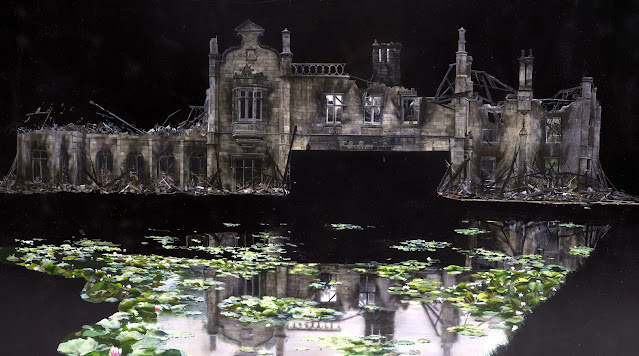 |
| Close up detail. |
.jpg) |
| Now here's a ripper.... Brian Flora's sublime matte from the Francis Ford Coppola version of DRACULA (1992) |
 |
| DRACULA final comp. |
.jpg) |
| Also from DRACULA was this beautiful Bill Mather matte. |
.jpg) |
| Final comp of Bill Mather's painting. |
 |
| Michael Pangrazio painted this chilly vista for a film titled PRANCER (1989) |
.jpg) |
| Another Pangrazio matte from a show titled STEAL THE SKY (1988), possibly a tv movie, though I've never heard of it? |
 |
| An atmospheric matte from the erotic-thriller MALICE (1993), probably by Mike as well. |
 |
| The comic book hero actioner THE SHADOW (1994) had a substantial matte and effects load, with the chores being split between Matte World and Illusion Arts. This is a Matte World shot, and though the Prop Store page says it's a Pangrazio matte, I seem to recall in correspondence with fellow MW artist Christopher Evans, that it was his matte. Great flick BTW. |
.jpg) |
| Detail. Note the unpainted strip which was intended to facilitate rear projected street traffic action. Note: A second, very spectacular and extensive wide overview of the Empire State viewing deck and city surrounds - also painted by Chris Evans - was sadly reduced to tiny shards of broken glass in a handling accident at Matte World. The Horror............. :( |
 |
| Now, this one's definitely interesting. It was painted on the rear of the SHADOW matte - hence the scraped away strip for RP - though the sheer vandalism here is unforgivable! Does a new sheet of glass really cost so much to break the sundries budget for Matte World? The auction site say's it's from THE SHADOW, though it doesn't resemble any scene that I can recall? |
.jpg) |
| Also from Matte World was this matte for BATMAN RETURNS (1992). Bill Mather was artist. |
.jpg) |
| BATMAN RETURNS finished shot. |
 |
| No, not from Matte World this time, but from Matt Yuricich! A wonderful canyon with busted down bridge as seen in the excrutiatingly awful teen sci-fi mess, SOLARBABIES (1986). |
 |
| Close up detail... |
 |
| Matthew Yuricich with brush in hand... |
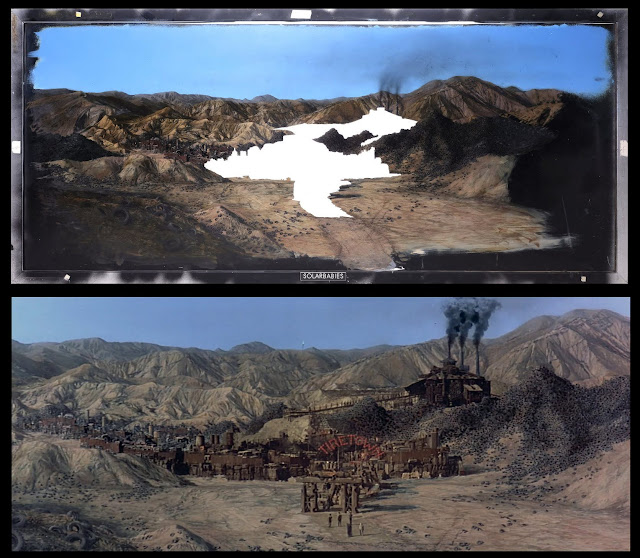 |
| Another shot from the mind numbingly dire SOLARBABIES, though this one I strongly suspect was the work of Michele Moen who was Matthew's long time friend and assistant matte painter. The technique doesn't suggest Yuricich's style. |
 |
| This one's from the still popular (original) GHOSTBUSTERS (1984). The final shot was a multi-part effect, with miniature street, guy in Stay-Puft suit, painted tenement buildings, foreground live action and nice cel animated elements. The final close up of the Marshmallow face may have been a puppet. Matthew Yuricich was chief matte artist, with Michele Moen and Deno Ganakes assisting. |
***This post, and all 180 previous blog posts known as 'Matte Shot', were originally created by Peter Cook for nzpetesmatteshot, with all content, layout and text originally published at http://nzpetesmatteshot.blogspot.com/ -------------------------------------------------------------------------------------------------------------------------
 |
| Long before Disney got entwined with often silly kiddie fare, the studio produced some solid, mature dramatic pictures. THE GREAT LOCOMOTIVE CHASE (1956) was one such film. |
 |
| The grand CinemaScope true story of Civil War rivalries and subterfuge, was a beautifully photographed, well written and directed affair, with often edge of the seat moments of action. Beautiful etchings too for the nice title sequence. |
 |
| Peter Ellenshaw was matte artist, with a screen credited Albert Whitlock as assistant matte painter. |
 |
| Various images of Peter at work, with the top right image of Peter in his Disney office whereby a key matte from the opening scene in GREAT LOCO is seen on wall behind him. |
 |
| The spectacular opening shot was a full Ellenshaw painting of mid 19th Century Washington DC. |
.jpg) |
| Now for a sensational examination of Ellenshaw's original 1956 matte - still in pristine condition - as it was presented for auction recently from the Ellenshaw family collection. |
 |
| Detail 1 |
 |
| Detail 2 |
 |
| Detail 3 |
 |
| Detail 4 |
 |
| Detail 5 |
 |
| Detail 6 Note the construction work on the Capitol dome. |
 |
| Detail 7. According to Peter's memoir, the whole painting took about 5 days to complete. |
 |
| I know that most - if not all - of the mattes in GREAT LOCO CHASE were made as in-camera foreground paintings on location, with some on glass and others on hardboard, or Masonite as the Yanks call it. All of the shots are rock steady making me wonder if this was the case, with only the final matte being an obvious dupe, and completed in post production. |
 |
| I asked Peter's son Harrison, and he was pretty certain the shots were all done as original in-camera shots on location with the large painted mattes mounted in front of the camera. Instant composite. |
 |
| Probably a full painting, as I don't recall any live action here. |
 |
| This is a great shot that nobody ever noticed. The true 'invisible trick shot'. As explained and illustrated below by the film's director, Peter supplied an entirely painted second story to the partial set. But who'd have ever known? |
 |
| Director Francis Lyon with Walt. Note the semi-built facade beyond, awaiting Peter's matte art. |
 |
| Some amazing frames taken from a very rare 1956 newsreel - probably made for the Disney tv series - where we can see Peter arrive at the location in a very, very tiny car, (I half expected 15 clowns to hop out!) with matte art roped to the roof(!) Subsequent footage shows Peter lining up the painting with the set, with assistant - possibly Whitlock - making final touches to blend the matte art with the set. I sent the video clips of this time capsule to Peter's son Harrison and asked him some questions about it. Harrison was of the opinion that his Dad likely didn't have a stand alone matte studio of sorts on the Tennessee location, but more likely just had his stack of Masonite panels, glasses, brushes, oil paints and turpentine on or in the grip truck nearby. I mentioned to Harrison how astounded I was at the apparent flimsiness and rough handling of the painted matte panel as Peter hauls it off the car, with it flexing and flopping all over the place(!) Harrison said that the oil painted artwork would have been quite flexible at that stage, and only dangerous and likely to cracking and peeling when aged and brittle. Oh, and he also mentioned that the helper seen working alongside Peter was most likely not Albert, and more likely just a grip, as Peter didn't take his assistants onto shooting locations as a rule. I do wonder though, as heavily unionised as is/was the US film industry, if a mere grip would be permitted to so much as pick up a paint brush, let alone apply pigment to a matte painting, without there being a huge hull-a-balloo and an all out strike! I've heard of union walk-outs on a stage when a cameraman moved a lamp a couple of feet to the side!! |
 |
Another great in-camera composite, made right there on location, where Peter has extended a small physical setting of a few tents, to a vast Confederate battalion and surrounding Southern countryside.
|
 |
| Another flawless foreground glass shot (see below). Not just the sprawling township had been painted in, but also the near foreground sheds and partial rail track on the grass. Neat. |
 |
| The specially constructed and secured raised platform with matte crew. A deep set up as they were shooting CinemaScope, with huge anamorphic lens and limited focal depth and inherent optical distortion at the edges, which were a limitation of the early Scope process, with the painted matte of the distant town etc positioned at an appropriate distance to ensure focus on both artwork and actual scenic setting. I recall reading in Peter's memoir that a train came along during the night when nobody was around, and knocked the huge trestle tower down! Presumably the glass painting wasn't yet installed? |
 |
| As mentioned, Al Whitlock painted on this - and many other Disney shows. In later years Albert would regale Bill Taylor as to how much he learned from watching Peter paint. Al said: "Peter never taught me. He just allowed me to observe him". Albert was able to pick up many of the short cuts such as the 'big brush' to sell a good matte from Ellenshaw, and said his own style loosened up considerably as a result then, whereas his early days in England Al's style, by his own confession, was "so tight, I'd be tied up in knots all of the time". |
 |
Ellenshaw's wonderful Civil War era trestle railway matte painting.
|
 |
| On location snapshots of Peter lining up his rough block in of the trestle train bridge for the above matte, and all in the sweltering summer Southern heat. |
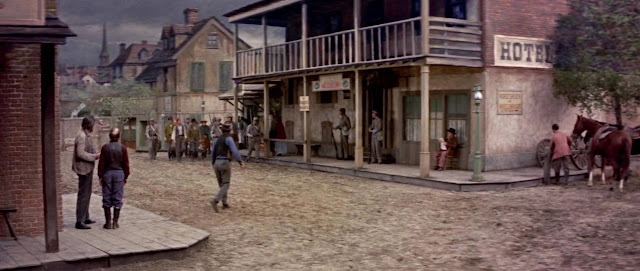 |
| One of the hazards when working with early CinemaScope, as mentioned, was a depth of field issue. That is apparent here as the foreground painted town and second floor hotel are slightly out of focus, probably due to a too wide an f-stop and not enough light. |
 |
| A virtually full matte painted setting of the Confederate Prison. Just a part of the courtyard was actual, with all else being artwork. I think the painting still exists in the Disney archives, as I've seen pics of it on the wall of the Buena Vista Visual Effects matte room from the mid 1990's. Here's hoping! |
 |
| The final matte, and the only one that looks as if it were a post-production composite, likely made as a rear projection comp, with a broad 90% entire painted scene, and a group of soldiers matted into a small 'pocket' mid frame. It has a very 'second generation' look about it, as opposed to the other work in the show. Still, a really good film from Disney, and like 20'000 LEAGUES UNDER THE SEA, made two years prior, represent the Mouse Factory at it's best in my humble opinion. (Are my 'opinions' ever reallllly 'humble'? Nahhh, probably not, but whatcha gonna do?) |
----------------------------------------------------------------------------------------------------------------------
 |
| I learned years ago as a kid attending endless Saturday & Sunday double bills, to always be wary of over zealous one-sheet artwork.... It still never stopped me from buying my ticket and watching the flick though! Damned movie advertising departments! |
 |
| The unwieldy tongue-twisting original title got shortened to VIKING WOMEN AND THE SEA SERPENT (1957). One of Roger Corman's earliest features, and as far as $10 flicks go, wasn't too bad, and the production value on screen somewhat exceeded expectations. |
 |
| Familiar names in the budget conscious world of 'B' pictures, Rabin, Block & DeWitt were constantly called to furnish cut price mattes, opticals, process shots, animation, models, titles and more for a hundred pictures from the late 1940's and well into the early 1980's. Jack Rabin (top left) was an old hand in opticals, camera fx and matte painting, having worked with legends like Jack Cosgrove at Selznick, and other periods at Warners and 20th Century Fox under Fred Sersen. Irving Block (top right and bottom right) was a veteran matte artist from MGM and also Fox, where he met Rabin and teamed up to open their own independent effects house with title artist Louis DeWitt (not pictured). |
 |
| VIKING WOMEN AND THE SEA SERPENT may have been a rush job, as most Corman pictures of the day were, but it did make good use of photographic effects on a slim budget. |
 |
| The band of spear wielding bikini clad Bronze Age babes are inspired to journey to the ends of the earth when witnessing this apparition in the sky, where the clouds form a sort of Viking galleon. Nice full matte art. |
 |
| The journey commences, with some surprisingly good rear projection supplementing their sound stage tethered vessel. Note the behind the scenes pic of process set up and stage hands armed with hoses. |
 |
| The demon beast of the North Sea makes his appearance. The puppet was dressed around the arm of fx artist Irving Block and filmed in a small tank. |
 |
| Probably would have looked cool at the Drive In when canoodling in your Chevy convertible with your gum chew'n bobby-soxer back in '57 |
 |
| Tragedy strikes, as does lightning, which sets their miniature galleon alight. Too late to remember the 'maritime safety drill' girls! |
 |
| Irving Block's full matte painting of the Viking village and castle. Nice shot. |
 |
| Following up, the gals and some burly 'surfer dude' looking Vikings, approach the castle. A substantial matte painting here, with not only the castle but the foreground trees, wall and archway all painted in. The actors' heads all get 'chopped' beneath the low hanging painted foliage though. |
 |
| The actual paintings by Block are surprisingly crisp and sharp, while in some cases like this, the live action plate is washed out and soft, suggesting possibly rear projected composite? |
 |
| Another interior set extension, with frantic 'Go-Go dancer' from days long gone. |
 |
| Hand puppet manipulated by matte artist - and general jack of all trades - Irving Block. |
 |
| A beautifully atmospheric matte by Irving, who, as an aside, the year before wrote the original screenplay for the big budget MGM sci-fi classic FORBIDDEN PLANET. |
------------------------------------------------------------------------------------------------------------------------
 |
| Time now for an expensive, lavish, Technicolor, major studio spectacle... And I do mean spectacle! THE BLUE BIRD (1940) received a completely deserved nomination for Best Special Effects that year, and to me, it was the strongest contender. More about 'Oscar injustices' later... |
 |
| Arguably the biggest box-office sensation of the thirties, and on into the early forties - Shirley Temple was 20th Century Fox's answer to printing their own money. A phenomenal draw card. THE BLUE BIRD (1940) was a sweet natured, vividly designed and lushly photographed family fantasy. This was the second of at least 3 versions of the film, with the first being a silent back in 1918, and the latter being in 1976. |
 |
| I'm assuming the film must have been a very expensive affair, what with the sets and the very extensive special visual effects requirements, a significant portion of the film later on is literally wall to wall effects shots, without let up! |
 |
Yes, I know I stated it was a lush, saturated Technicolor affair, but bear with me, THE BLUE BIRD does commence in black & white - as did a similar film THE WIZARD OF OZ in Sepia-tone - but the story switches into all of the colours of the rainbow once the magic kicks in. This opening sequence is a gem, and one that passes by completely unnoticed as a trick shot. The Austrian alpine town was a substantially large matte painting mounted on set as a foreground glass shot so as to permit a natural, fluid camera move as the characters walk through the woods. Naturally, being wartime in Europe in 1940, no scenes could be shot on location, nor would it be expedient to ship Miss Temple all the way across the pond for just a couple of establishing shots. See below for more...
|
 |
| The impressive glass shot with camera move (shown twice in the film, both moving to, and away from the distant village). Fox were absolutely 100% gung ho about carrying out trick shots using this method, with the legendary master Fred Sersen being a firm believer in the gag, as engineered on countless Fox films over the decades, and all with absolutely convincing, first generation quality. The foreground trees strategically conceal the rigging for what must have been a very large painting. Love this stuff! |
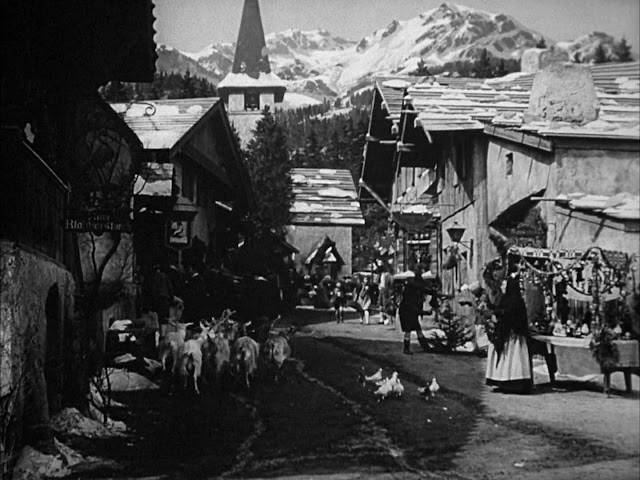 |
| Matte shot made on the Fox back lot for THE BLUE BIRD (1940) |
 |
| The flick kicks into full steam ahead Technicolor once the kids are given the mission to seek out the 'Blue Bird of Happiness'. A nice optical transition here, no doubt overseen by Fox's long time optical department head, James B. Gordon. |
 |
| The kids on their journey into a magical otherworld, filled with matte art, optical combinations, miniatures and absolutely eye-popping devastation that must have given kids nightmares back in the day! |
 |
| As I've written extensively in my blogs, Fox had a huge photographic effects department, and certainly one of, if not the best in Hollywood. Fred Sersen ran a very tight ship, and didn't suffer fools gladly. Sersen himself was primarily a matte painter, beginning in the 1920's, and ventured into effects cinematography. Fred was nominated for the Best SFX Oscar some 8 times and won twice. |
 |
| Sersen's long time right hand man and assistant, Ray Kellogg, was key matte painter on BLUE BIRD, with Ray being instrumental in a great many fine effects films produced under the Fox banner for some years, eventually becoming head of the effects department in the early 50's. |
 |
| Painted in ornate ceilings were very much a part of the golden era of matte work. A cost saver and a means of concealing the bothersome rigging and lighting fixtures above the main set. |
 |
| The kids, the kindly old guy and the evil Gale Sondergaard (you just know she's gonna be trouble as soon as you see her name in the credits!) enter the forest where all hell breaks loose. Many matte painters worked at Fox at the time this was made. Names such as Ralph Hammeras, Clyde Scott, Joseph Serbaroli, Hector Serbaroli, Emil Kosa snr & jnr, Gilbert Riswold, Fitch Fulton, Menrad von Muldorfer, Chris von Schneidau, Ray Kellogg, Barbara Webster, Charles W. Hulett and Max DeVega. |
 |
| Delightfully fanciful matte painted top half of set. |
 |
| The tranquil forest is deceiving. A mega storm rolls in and much trouble comes with it. An excellent vfx shot here, with miniature trees and a brilliantly orchestrated raging storm forming above, with lightning and all. Don't know how Fred did this shot? I'd guess a separate 'storm plate' with perhaps time lapse clouds, lightning animation optically added, and this all rear projected behind a miniature forest mounted horizontally, with the process 'flash' catching naturally upon the model tree props? |
 |
| And so begins one of the most superbly executed and complex photographic effects set pieces I've ever seen, and one that lasts for several minutes of non-stop screen action. The static frame captures don't even come near to illustrating the dynamic, state of the art vfx sequence. Seriously! |
 |
| The violent thunderstorm and lightning strikes and causes a catastrophic firestorm that devastates the entire forest. One of the finest effects sequences ever committed to celluloid, with each and every shot being a manufactured Sersen department effect. Miniatures, mechanical fx, pyrotechnics, mattes, roto animation, optical combinations, process, and often all of these merged in single shots! The shot above has the group running for their lives as lightning brings down a massive tree just as they pass under it via perfect frame by roto work. One of numerous jaw droppingly complex shots that saw the film nominated for the FX Oscar. All carried out with large miniature forest set, with actors added in through travelling mattes... and in 1940 Technicolor! |
 |
| More of same, with vast miniature set with falling trees crashing down just short of crushing our young cast through precise rotoscope matting. |
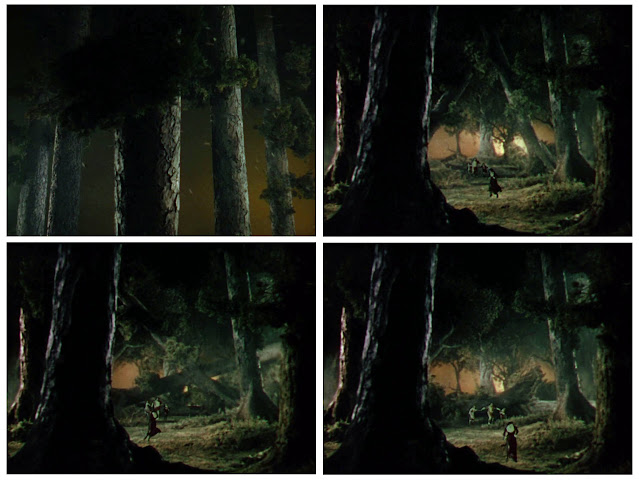 |
| When viewed in motion, the work is sublime, and one can but wonder of the time spent on the lengthy sequence (much more still to come...) |
 |
| Travelling matte comp at left, with highly effective RP comp at right. Sol Halperin was Fox's process specialist, and he had a life long association with the studio. |
 |
| The only film I've ever seen with comparable model trees uprooting and falling down was the outstanding Academy Award winning work of Arnold Gillespie and Donald Jahraus for GREEN DOLPHIN STREET (1947), though that wonderful work was in black and white. |
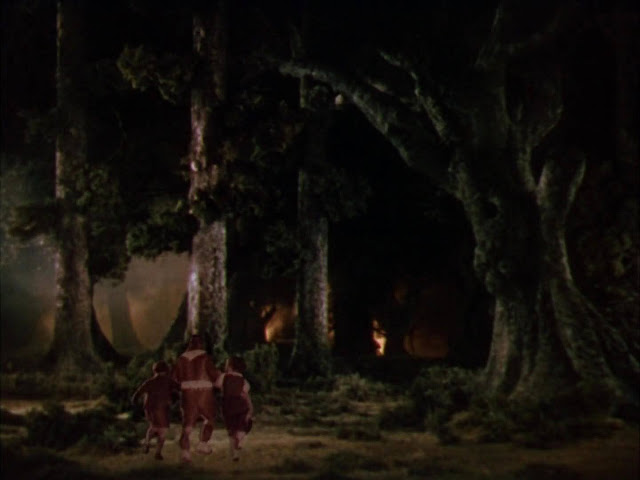 |
| Superb miniature cinematography, with the good depth of field suggesting a very sizable miniature set, probably occupying a substantial piece of back lot acreage, much as Sersen did for epic effects films like THE RAINS CAME and IN OLD CHICAGO - both astonishingly fine fx films. |
 |
| The scale of the pyro and actual fire physical effects suggest very, very large model trees. I'd hazard a guess at these being some 8 to 10 feet in height(?) |
 |
| Again, the realistic scale of flame enveloping the falling tree is so impressive. |
 |
| Effects cinematographers at Fox included Artilio 'Til' Gabbatini, Al Irving, Lenwood Ballard (L.B) Abbott, Ralph Hammeras, Edwin Hammeras, Harry Dawe, James B. Gordon & Paul Mohn. |
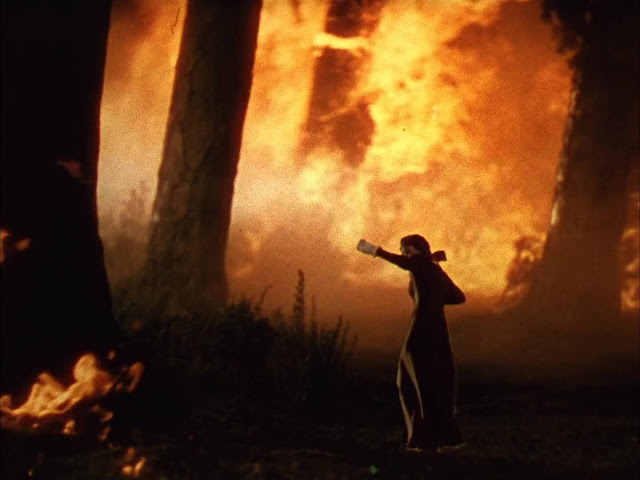 |
| Outstanding composite optical photography. I don't know what method was used to shoot and isolate the actors and create silhouette mattes, especially given this was early 3-Strip Technicolor? The optical line ups and associated roto enhancements, where required, are still mind blowing. Did I mention that this was all nineteen forty and 3-strip Technicolor? |
 |
| BLUE BIRD was one of some, amazingly, 14 (yes, fourteen no less) films up for the Best Visual Effects Oscar in 1940(!!!) The line up was an odd mixed bag of titles and studios: BOOM TOWN (MGM); THE BOYS FROM SYRACUSE (Universal); DR CYCLOPS (Paramount); FOREIGN CORRESPONDENT (United Artists); INVISIBLE MAN RETURNS (Universal); THE LONG VOYAGE HOME (United Artists); ONE MILLION BC (Hal Roach); REBECCA (Selznick); THE SEA HAWK (Warner); SWISS FAMILY ROBINSON (RKO); TYPHOON (Paramount); WOMEN IN WAR (Republic) and THE THIEF OF BAGDAD (Korda) which won the Oscar. Now, I've seen 12 of those films, and as good as THIEF OF BAGDAD was, I don't feel it should have taken that Oscar. The travelling matte work and miniatures in BLUE BIRD were exceptional in my book, and should have been rewarded. Among the others here, BOOM TOWN would have been a runner up in my book - outstanding trick work by Arnold Gillespie, Warren Newcombe and Irving G. Ries. |
 |
| Absolutely terrific rear projection work supervised by Sol Halperin. No mean feat as RP work in Technicolor was usually dreadful, with ghastly washed out process plates, unstable images and lacklustre colour. Very 'slow' 35mm film certainly hindered things, but the work here in BLUE BIRD stands head and shoulders above the rest... and it was 1940! I don't know if Halperin had any sort of double or triple head projection gear as other studios did, but I assume so due to the richness of the plates as combined with the action. |
 |
| Spoiler alert: The scheming and snarling Gale Sondergaard gets too close to the conflagration. Superb miniatures, physical effects, camerawork and optical compositing. Oscar worthy alone. |
 |
| I'd so love to see a breakdown and behind the scenes pics from this film. If you've got any, you know who to contact :) |
 |
| Again, excellent process work, and mind bogglingly bloody good miniature/optical combination work. It don't get much better than this folks.... and at risk of repeating myself, this was nineteen-fucken-forty, not 1980, and bulky, cumbersome old 3-strip Technicolor to boot! |
 |
| I did lighten up some of these shots a little, as the sequence is at night and the copy I have is quite dark, hence some matte lines here which aren't visible in the actual film as it runs. |
 |
| Who ever said that lightning never strikes twice? |
 |
| The 'kids in peril' aspect must surely have frightened young audiences of the day. |
 |
| Made all the more devastating with the sound editing by Edmund Hansen and Roger Heman, who, as was the Academy nomination selection system for decades, the sound supervisor or sound fx re-recording guy, were always automatically co-nominated with the visual effects guy. It always seemed so strange an arrangement. |
 |
| Other celebrated effects films from 20th Century Fox that also utilised extensive 'insertion' of live actors within miniature settings via travelling mattes included THE RAINS CAME (which won the Best FX Oscar in 1939); IN OLD CHICAGO; THE BLACK SWAN; SUEZ; CRASH DIVE; DANTE'S INFERNO; THE RAINS OF RANCHIPUR and many more. The Sersen unit really were leaders here. |
 |
| Oh, brother... what a breathtaking shot! |
 |
| Words fail me... |
 |
| Probably the best fx shot in THE BLUE BIRD, with this completely out of control, raging inferno almost enveloping our fresh faced cast. Man, this must have looked a million dollars up on the big screen at the local Odeon back in the day. |
 |
| Too many frames do I hear you mutter? I don't like to do these things by halves, and fine visual wizardry absolutely deserves as complete a coverage as possible. Agreed? |
 |
| A stray fireball ignites and brings a huge tree down, almost obliterating Miss Temple and pals. |
 |
| You can practically feel the intense heat from here! |
 |
| I'm incredibly impressed with how well the physical fire aspects of these shots were handled. The utmost in carefully designed and executed 'miniaturised pyro' - not an easy element to control. The scale factor here is as good as anything else I've ever seen. Really should have taken home that elusive Oscar that year! |
 |
| The trio escape the conflagration and drift downstream to where the most exquisite of 'good fairies' has a meet & greet. Mostly painted shot here of course. |
 |
| After all the big budget commotion that preceded it, the kids finally get to go home and find their Blue Bird of Happiness right on their doorstep. And they all lived happily ever after... excepting Gale Sondergaard, who was spectacularly burned to a crisp, but she deserved it because she wasn't really very nice at all. |
--------------------------------------------------------------------------------------------------------------------------
 |
| Oh yes... I absolutely love a good WWII flick, with the British action true account THE SILENT ENEMY (1957) being a solid, gripping, worthwhile event. |
 |
| A Shepperton Studio production, the film is packed with special effects, mattes and miniature work, all supervised by veteran Wally Veevers. |
 |
| An impressive opening shot of a huge fleet in the port of Alexandria, Egypt, was a superb matte painting, likely by Bob Cuff, who described painting on this film. Bob was one of Wally's foremost artists and worked on scores of notable British films such as HOBSON'S CHOICE, MASQUE OF THE RED DEATH, MACKENNA'S GOLD, COLDITZ STORY, THE GUNS OF NAVARONE and THE ADVENTURES OF BARON MUNCHAUSEN. Bob also worked on Kubrick's 2001 with Wally, whereby as a change of pace, he created forced perspective physical moonscape miniature sets. |
 |
| A serene maritime setting just prior to a major underwater demolition job. An entirely manufactured visual effects shot utilising Wally's preferred method of matting miniature (or painted) ships into real water, complete with a superb painted sky. I can't be certain whether these ships were models or painted, but feel after several viewings they are likely matte painted, almost certainly by Bob Cuff who just loved intricate, highly detailed work such as this. |
 |
| Same harbour setting in a subsequent day shot leading up to the dramatic action piece. Once again, not entirely sure but feel the ships possibly painted on a separate plane to the painted city and sky beyond. |
 |
| Frames from the moment of destruction, with excellent cel animation supplemented mine explosion. |
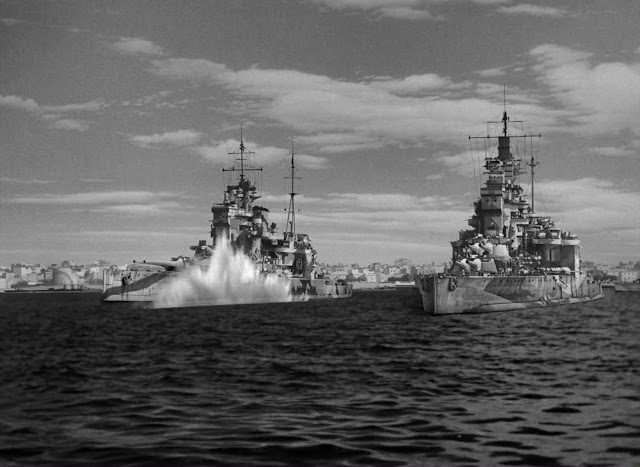 |
| Complex shot with an already multi-element composite further extended with additional matted in explosion element. |
 |
| I think it's a really impressive photographic effect, even considering the bottom of the 'explosion plate' set up is clearly evident here as still frames, but never visible really in the actual sequence. Probably some soft roto mattes around the water eruption to excellent blend result. |
 |
| Wally was himself, an experienced vfx cinematographer, with a substantial catalogue of films and trick shots under his belt. For many years he was matte cameraman to the legendary Walter Percy 'Pop' Day, and they worked together until Day's retirement, at which point Veevers assumed command of the Shepperton effects department around 1952. Wally had a knack for inventing devices and equipment for effects shots, usually at home in his workshop where all the tools were at hand. He developed important 'motion repeater' devices for shooting mattes and models on films like THE BLACK ROSE and BATTLE OF BRITAIN and contributed enormously to Stanley Kubrick's 2001. |
 |
| The second destroyer blows sky high as well. Again, a very complex combination visual effect scene here, and to add the icing to the cake, Wally has this second ship sway violently from the blast, coming close to a capsize. Absolutely superb fx design and execution here, and my hat's off to Wally and his unit. |
 |
| Again, I'm trying to figure whether it's model destroyer action or painted, with the otherwise static glass painting tilted frame by frame to suit what will be an explosion element doubled in later. Note: Many years later Al Whitlock also used a similar 'frame by frame tilt' of a large painted glass of the HINDENBURG zepplin, hand cranked one frame at a time, for the shot at the climax where the airship explodes and drops down a few degrees at the mooring mast in New Jersey. This SILENT ENEMY sequence is incredibly well done, though if my reader(s) are more of the 'DC'/'Marvel Universe' bent, then this will all be so nil interest, sadly. |
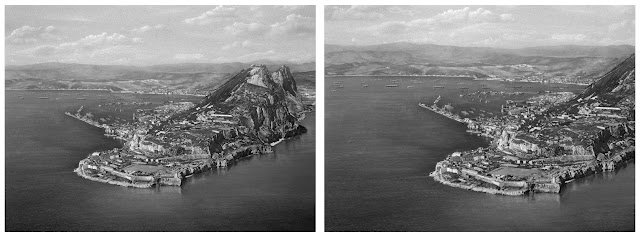 |
| The Rock of Gibraltar and harbour filled with warships, as viewed from an airplane, was a full matte painting, again likely another of Bob Cuff's mattes. Bob was a highly respected technician in the UK film industry. I was sharing some emails with Kent Houston, whose fx company Peerless Optical in London, would always try and go out of his way to try to secure Bob's services for any matte assignments on film, tv and commercials. Kent told me that Bob was an absolute gentleman, as well as the finest matte artist he'd been involved with. |
 |
| Matte painters also working alongside Bob at Shepperton at the time included Albert Julion, David Hume and head matte painter, George Samuels, the brother of Ted Samuels, who was chief physical effects man for many years. |
 |
| Massive maritime miniature mayhem. Sadly, the high speed photography wasn't anywhere near 'high' enough to scale down the boom sufficiently. I don't know what high speeds were possible back in the 50's.... probably not much more than 72fps - at most - I'd imagine? |
 |
| Plane shot down was a split screen job with model plane in tank with painted backing at Shepperton, while the foreground ocean is the real deal, matted in, as Veevers often did, to lend an authentic scale to the sea. |
 |
| Looks like the exact same 'explosion' element used for the ship scenes earlier on. |
 |
| Matte art from just above Laurence Harvey's head. |
 |
| A full matte painted night scene with real ocean plate added in. |
 |
| More midnight mass destruction in miniature, though as mentioned, the shots didn't quite have a slow-enough motion to bulk it all out. Wally's effects cameramen, with him for many years, were John Mackie and Peter Harmon. |
 |
| Split screened in foreground action with an extensive painted view of the ship and background vessels. |
 |
| Multi-part composite: Real foreground water, painted ships, and various explosion elements strategically placed to excellent effect. |
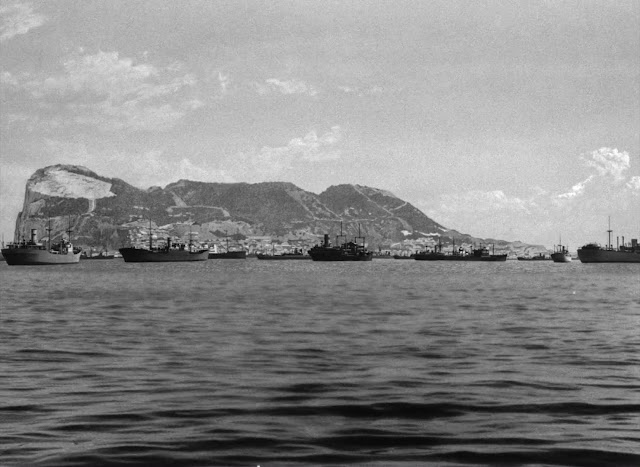 |
| Gibraltar harbour chock-filled with ships. The ships are all matte painted, and I assume the Rock itself and sky could be too, but I might be wrong? Possibly an actual live plate of Gibraltar and port, with just the Navy painted on glass, which on reflection I'd tend to think is the deal here. |
 |
| Now, this shot is very cool. Practically a full screen matte painting - even the close foreground with even the jetty and rope, as well as all of the sea traffic! Just a portion of 'real' ocean matted in for about the mid quarter of the frame. |
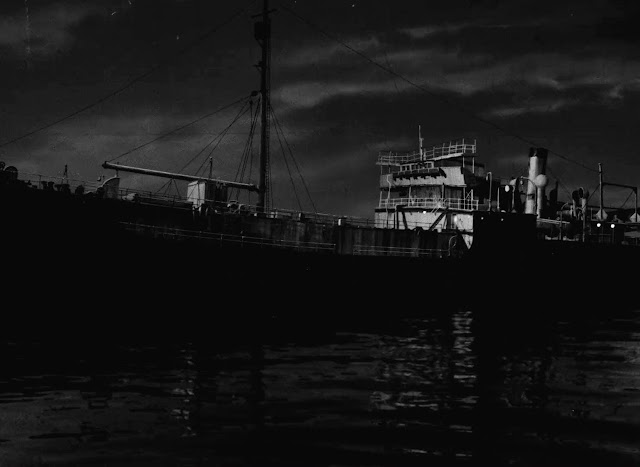 |
| Large miniature, filmed in the tank this time. |
 |
| The Merchant Navy suffers yet another blow... |
 |
| A single frame - with each successive frame being dramatically different - from the cel animated underwater mine explosion. Looked good in final shot. |
 |
| Final scene, possibly a mix of foreground miniatures in tank(?) and extensive matte art for rest of it. The distant ships are all on a single moving glass, as all travel in unison at the same speed. |
 |
| So, all up, a great movie if you're anything like NZ Pete, who loves these 'special commando/saboteurs on dangerous mission' type scenarios. I read tons of true life accounts and have many books on WWII. |
-----------------------------------------------------------------------------------------------------------------------
 |
| Paramount's grand, Technicolor costume extravaganza, OMAR KHAYYAM (1957) was a pretty hokey affair, but then most of the 'desert romance/high adventure' flicks of the day weren't much more. |
 |
| As with all preceding Paramount logo's, this grand, widescreen rendering for the studio's VistaVision high resolution camera negative process, was painted by old time matte painter Jan Domela. |
 |
| John P. Fulton was in charge of the photographic effects, which included mostly matte art and a bit of miniature work at the end. Farciot Edouart always made damned sure he got his name up on screen on every Paramount film, even though in this case it just amounted to one or two process shots. I was told a funny story about Edouart. As well as being quite arrogant and self important, he was determined to remain with the studio long into the break up of the special effects department, when Gulf & Western were cutting costs in all departments. Every time the 'suits' from the head office in NYC came to the Hollywood lot, Farciot would run off and literally hide in little 'boltholes' he knew about, scattered around the lot, in an effort to save his neck from the hatchet-men and their metaphorical axe! They caught him in the end, and I'll bet he was lead away kicking and screaming(??) Only in Tintseltown! |
 |
| Quite a number of painted mattes were used for OMAR KHAYYAM, with the usual duo of fx cinematographer Irmin Roberts (extreme left) and painter Jan Domela providing the shots. |
 |
| The first matte was this view of the Holy city - a matte that was originally painted by Jan the year before for Alfred Hitchcock's THE MAN WHO KNEW TOO MUCH (1956). Jan has altered and repainted small details here for the more 'historic era' context of OMAR KHAYYAM. See below for the original version for Hitchcock's film. |
 |
| The original Hitchcock matte art, seen at two different times of day. Note in lower frame the matting in of Muslim prayer guys on Minarets etc, as well as small cranes and refurbishing construction equipment, all of which was painted over for the OMAR film. |
 |
| A grand establishing shot, also entirely painted. Jan Domela would get upset with how some of his carefully chosen hues would show quite skewed when composited. Jan's daughter told me he would complain about "cameramen and their use of filters that altered his colour schemes". For evidence, see below... |
 |
| A rarity indeed, inasmuch as no Paramount Studio mattes are known to still exist, unlike MGM for example, where hundreds are floating around out there. In Jan's daily studio diary he mentioned pulling the matte from storage and 'filling in' the blacked out area for it to be used as a 'stock matte' for subsequent productions. |
 |
| Detail 1 |
 |
| Some peeling and chipping of Jan's oil pigments evident. |
 |
| More detail. Note Jan's gentle colour scheme when compared with the off-kilter final production comp. |
 |
| Some fine close up detail. The matte is in the care of Jan's daughter, and she said "he just came home with it one day". |
 |
| Evening outside the palace. Note the oddly off-centre tower at right?? |
 |
| Our swarthy hero, Cornel Wilde, rides toward the impressive mountain top fortress of the strange cult lead by Michael Rennie (so good in many other films such as the brilliant THE DAY THE EARTH STOOD STILL, though, I digress...) |
 |
| Unfinished test from Jan's album. Looks like the 'craft service' wagon at extreme right? |
 |
| It was a solidly built, near indestructable fortress ... though it did have one fatal flaw! |
 |
| A very nice matte here. |
 |
| The luxury penthouse atop Michael Rennie's 5-star, high rise, sacrificial, religious cult pad. Groovy baby. |
 |
| Militia encampment at dusk, as per Domela's matte art. |
 |
| The sunrise strikes the golden dome. Matte painting with an added glow effect, maybe as an optical superimposition? |
 |
| Things turn for the worst, as the attackers discover a clever ploy to destroy the mountain from within. Possibly a matte painting here with miniature upper part, or an entire miniature set up? |
 |
| The Fulton department were still likely running on a high, having won the Academy Award for Best Visual Effects the year before for DeMille's THE TEN COMMANDMENTS. |
-------------------------------------------------------------------------------------------------------------------------
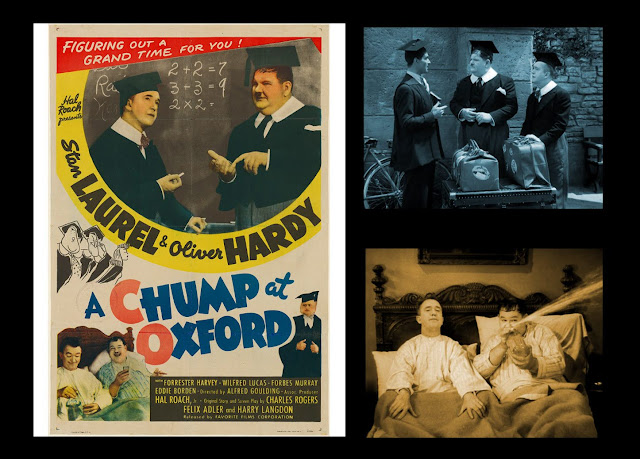 |
| Laurel & Hardy's feature length films were often something of a mixed bag. Seemingly unrelated 'sketches' or irrelevant set pieces tacked loosely together to form an ill fitting hour and ten minutes of mischief. Still, I'll always watch 'em as I like old time comedians, though the utter brilliance of The Marx Brothers will always be my 'desert island' box-set choice by a country mile. |
 |
| Produced by the small Hal Roach Studio, A CHUMP AT OXFORD (1939) had it's fair share of laughs and clever bits by the highly experienced duo. Roy Seawright was in charge of Hal Roach's photographic effects department as usual. |
 |
| For a small outfit, the Seawright department at Hal Roach made every cent count, and the on screen results time and again were impressive in many films such as ONE MILLION BC, TOPPER RETURNS and BONNIE SCOTLAND - all effects heavy films. Pictured here (main photo) is Roy Seawright with matte camera, and Jack Shaw, old time matte painter on scores of films for Roach, Selznick and Warner Bros. Top right; an overview of the effects workshop in 1939, with Jack Shaw at left with a horizontal matte stand; optical cameraman William Draper in middle and Seawright with optical man Frank W.Young next to optical printer. Bottom right: Draper, Young & Seawright with matte set up. |
 |
| England's illustrious Oxford University, as depicted on the Hal Roach studio lot, with Jack Shaw's matte painting. |
 |
| A very funny extended set piece has our dumb duo trapped in a hedge maze, courtesy of student bully played by none other than the great Peter Cushing in his first screen role. Now, if you look carefully (forget it if you are on a fucking cellphone... worthless for these blogs!) you'll spot a superbly integrated flock of birds flying across the painted matte to lend some life to the effect - probably as a bi-pack element. Now, this was extremely rare in those days, and I can only think of a couple of other examples where animated birds have been introduced into a static matte or matte composite. KING KONG, THE MOST DANGEROUS GAME, SHE, and possibly the original LOST WORLD did it too. |
 |
| A second view of the hedge maze, with practically all of it painted. |
 |
| The matte painted clock tolls at midnight... |
 |
| Night view as Cushing and his bullies get into their ghostly get-up for a prank. |
 |
| Bully gets jettisoned out of window, with Jack Shaw's painted Oxford University matted in. |
 |
| Final matte, as bully-boy hits the pond. |
------------------------------------------------------------------------------------------------------------------------
 |
| Now, to round this all up, as a small tribute to the recently departed songstress, Tina Turner, I have the two mattes from TINA: WHAT'S LOVE GOT TO DO WITH IT (1993). Incidentally, I liked Tina but never cared much for her later career stuff. Give me Proud Mary, River Deep Mountain High or the exceptional Nutbush City Limits any day of the week. Man... that gal could hold a tune! |
 |
| The Ken Marschall-Bruce Block vfx operation Matte Effects handled the contract for this film, though due to heavy commitments at the time they brought in another matte artist for this shot. Embarrassingly, neither Bruce nor Ken could recall who did this painting. Ken thought it was fellow matte exponent Rick Rische, who did some work for them at times, but I'm fairly sure Rick said it wasn't his shot. Anyway, a totally invisible matte, made, as was their motto at Matte Effects, on original negative. |
 |
| The second matte was one of Ken Marschall's, and as usual, it was absolutely superb. Here is the original Los Angeles plate photography, the conceptual painting by a member of the film's art department, and the plate masked off for Ken's painting to transform the LA neighbourhood to one of St Louis in the early 1960's. See below... |
 |
| Ken's magnificent matte painting, rendered with his usual exacting attention to detail and photo-real finish, much as a fine art illustrator would do, quite the opposite to other notable artists of the traditional era such as Whitlock, Yuricich, Ellenshaw jnr and Dutton, who would use a far more impressionistic approach, with liberal brushwork and broad block ins. |
 |
| The flawless, finished original negative composite, from Ken's own 35mm sample reels. Incidentally, the work went uncredited as did so much of their matte assignments. |
 |
| A closer view, with Ken's hand deliberately shown to demonstrate the very small size of his painting. Ken told me in my exhaustive 2015 three part career piece how he would usually paint his mattes while sitting down, on art card, laying flat atop his dining room table at home, in acrylics usually, though when needed he would use coloured pencils, vivid marker pens, sometimes airbrush and whatever else needed. Unlike other matte guys, Ken would use the tiniest brushes available on the market, and could never quite get his head around 'the big brush technique', nor the thought of standing at an easel for hours on end. Ken and Bruce's little two man effects house was an industry secret. They never went looking for jobs, most just came as word of mouth, often from Gene Warren jnr. For 20 plus years they had more than enough work to keep busy, and always wanted to remain 'below the radar'. |
-------------------------------------------------------------------------------------------------------------------------
***This post, and all 180 previous blog posts known as 'Matte Shot', were originally created by Peter Cook for nzpetesmatteshot, with all content, layout and text originally published at http://nzpetesmatteshot.blogspot.com/
POSTSCRIPT OF NOTE:
.jpg) |
| As promised... a key special visual effect in DIAMONDS ARE FOREVER was the magnificent Lana Wood - younger sister of the late Natalie Wood. One of my fave Bond films, with screenwriter Tom Mankiewicz giving Lana a wonderful introduction to Sean Connery at the blackjack table. LANA: "Hi... I'm Plenty". SEAN: "Why of course you are!". LANA: "No, I'm Plenty...Plenty O'Toole". SEAN: "Named after your father perhaps". Cracks me up every time I've seen this flick... and that's about 30 times. |
---------------------------------------------------------------------------------------------------------------------
I hope this blog post proved interesting, illuminating, entertaining, irreverent and educational...
Do pass on your feedback or comments as I always welcome that.
Oh, and keep tuned for Tom's YouTube documentaries.
Peter



.jpg)

.jpg)
.jpg)

.jpg)

.jpg)
.jpg)







.jpg)














































































.jpg)


.jpg)
.jpg)


.jpg)
















































































.jpg)
Pete...you're a legend,as always.
ReplyDeleteMy evening is sorted,good stuff.
greetings,William
Thanks William..... there's a lot here to study and enjoy.
DeleteAll the very best
Pete
Great stuff, Pete!
ReplyDeleteI was just admiring the miniature effects in Passage to Marseille (which you have covered in previous blogs) and began to wonder for the second time this month about "seafaring" tank miniatures. More specifically, how rolling wave motion was achieved on the camera side of things, and what kind of camera platform might have been used to create that motion smoothly, or support a camera in the water.
I don't see it here, but the 1979 miniseries of Tinker Tailor Soldier Spy uses mattes to turn Glasgow into Brno, Czechoslovakia (as was).
ReplyDeletehttps://pics.imcdb.org/10314/12-22simcad.jpg - I think the awning is a painting.
https://pics.imcdb.org/10314/12-08kadettc.jpg - Watt Brothers dept. store given a few more stories, and some additional buildings at the back.
Hi George
DeleteI have the double box set of both TINKER and SMILEY mini-series, though never picked any trickery. I must take another look.
Pete
This page was as incredible as your whole site. Unfortunately (for me) I saw "The Blue Bird" about half a century ago on a tiny b/w television and was bored to death, what with ten thousand commercials and all. I have to see it anew!
ReplyDeleteHi Garry
DeleteThanks for those generous remarks on my site. I do appreciate it very much as it makes all of the hard work seem worth while.
BLUE BIRD - not a great film, but certainly what I'd call a technical marvel, especially when seen in glorious Technicolor. Truly amazing visuals throughout that are worthy of rediscovery.
Oh, and the BluRay doesn't have damned commercials!
Peter
Pete, a question just for fun.
ReplyDeleteYour top 5 fave matte paintings is....
greetings as always, William
Hey Pete, fully agree about the forest fire from Blue Bird. It really showcased the advantages of traveling mattes over rear projection, as they're continually used to depict the characters running from or toward the background, enabling them to enter the miniature set rather than run in front of it.
ReplyDeleteThat one high angle wide shot is also my favorite. Holding the shot for 12 seconds, the Sersen team really lets you scrutinize their work, which holds up so damn well. Early Technicolor traveling mattes almost always suffered from unnatural color shift between the actors and the background - as seen throughout Thief of Bagdad (1940), where the actors always have a blue or greenish tinge. But here the integration is near perfect, which is even more impressive when considering the many high angles that show their feet touching the separately filmed ground. To this day, avoiding the appearance that the actors are floating over the ground in such compositions is a challenge – yet the Sersen department grounded them incredibly well back in 1940.
Also the pyro work is just.. wow. Utterly mesmerizing stuff.
Hi there Joe
DeleteWow... the first I know to agree and regard the BLUE BIRD work as absolutely first class. And the sequence lasts such a long, long screen duration, so the number of individual fx cuts was mammoth.
Yep, the miniature pyro remains utterly mind blowing, and so well shot, lit and integrated - with excellent depth of field (often a flaw in Technicolor model work of old, with slow lenses & film ASA and such).
Fred's department really earned their pay cheque on that film, and it really should have snapped up the Oscar that year.
So glad you got a kick out of this article.
Pete
I really enjoyed reading your blog. I keep checkin' in to see if there's anything new. I hope there's more to come! Thanks for your work, and for sharing.
ReplyDeleteHi Kenray
DeleteThanks for the note of appreciation. Yes, there is more to come, though I have to 'get in the mood' to tackle these big posts.
Watch this space, as they say..... ;)
Pete